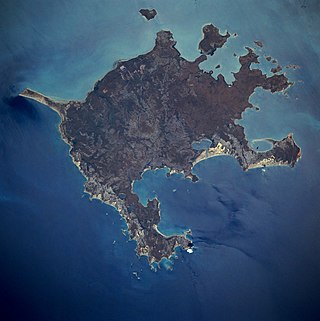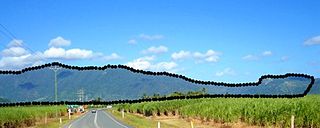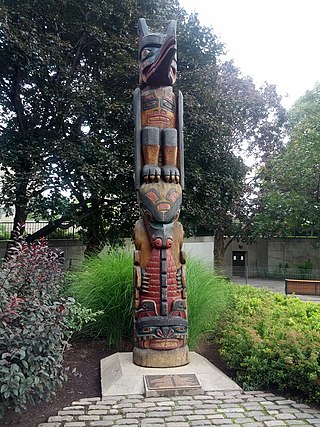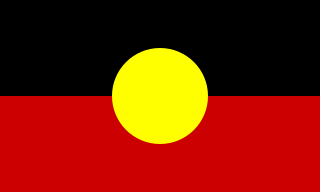
Groote Eylandt is the largest island in the Gulf of Carpentaria and the fourth largest island in Australia. It was named by the explorer Abel Tasman in 1644 and is Dutch for "Large Island" in archaic spelling. The modern Dutch spelling is Groot Eiland.

Australian Aboriginal religion and mythology is the sacred spirituality represented in the stories performed by Aboriginal Australians within each of the language groups across Australia in their ceremonies. Aboriginal spirituality includes the Dreamtime, songlines, and Aboriginal oral literature.

A totem is a spirit being, sacred object, or symbol that serves as an emblem of a group of people, such as a family, clan, lineage, or tribe, such as in the Anishinaabe clan system.

Indigenous music of Australia comprises the music of the Aboriginal and Torres Strait Islander peoples of Australia, intersecting with their cultural and ceremonial observances, through the millennia of their individual and collective histories to the present day. The traditional forms include many aspects of performance and musical instrumentation that are unique to particular regions or Aboriginal Australian groups; and some elements of musical tradition are common or widespread through much of the Australian continent, and even beyond. The music of the Torres Strait Islanders is related to that of adjacent parts of New Guinea. Music is a vital part of Indigenous Australians' cultural maintenance.

John Rudder, PhD, has studied the Australian Aboriginal languages, of Arnhem Land (Gupapuyngu) in the Northern Territory and the state of New South Wales (Wiradjuri), Australia.

Makassar people from the region of Sulawesi in Indonesia began visiting the coast of Northern Australia sometime around the middle of the 18th century, first in the Kimberley region, and some decades later in Arnhem Land. They were men who collected and processed trepang, a marine invertebrate prized for its culinary value generally and for its supposed medicinal properties in Chinese markets. The term Makassan is generally used to apply to all the trepangers who came to Australia.

Norman Barnett Tindale AO was an Australian anthropologist, archaeologist, entomologist and ethnologist.

Aboriginal Australians are the various Indigenous peoples of the Australian mainland and many of its islands, such as the peoples of Tasmania, Fraser Island, Hinchinbrook Island, the Tiwi Islands, and Groote Eylandt, but excluding the Torres Strait Islands. The term Indigenous Australians refers to Aboriginal Australians and Torres Strait Islanders collectively. It is generally used when both groups are being discussed. Torres Strait Islanders are ethnically and culturally distinct, despite extensive cultural exchange with some of the Aboriginal groups. The Torres Strait Islands are mostly part of Queensland but have a separate governmental status.

Anindilyakwa is an Australian Aboriginal language spoken by the Anindilyakwa people on Groote Eylandt and Bickerton Island in the Gulf of Carpentaria in the Northern Territory of Australia. Anindilyakwa is a multiple-classifying prefixing language in which all traditional nouns, adjectives, personal and demonstrative pronouns are prefixed for person, number and gender. According to the 2021 Australian Census, Anindilyakwa was spoken natively by 1,516 people, an increase from 1,283 in 2006.
Adnoartina is known as a religious deity in the Australian Aboriginal culture. This deity is described as taking the form of a gecko lizard and is considered to be a sacred ancestral being. Adnoartina offers an Indigenous understanding to the creation of Uluru, an Australian historical landmark. This landmark is regarded as one of the most sacred land formations in Australia and an ‘iconic’ tourist attraction. As Adnoartina is a key figure in the creation of Uluru, this deity is a symbolic figure in the Aboriginal religion.
Angurugu is a community located on Groote Eylandt in the Northern Territory, Australia. The main spoken languages are Anindilyakwa, an Australian Aboriginal language, and English. Established as a Mission for the Church Mission Society, it is one of the three main indigenous settlements on the Groote Eylandt archipelago alongside Milyakburra and Umbakumba. According to the 2016 Census, the community had a population of 855, a decrease from 882 in 2006.
The Tingari (Tingarri) cycle in Australian Aboriginal mythology embodies a vast network of Aboriginal Dreaming (tjukurpa) songlines that traverse the Western Desert region of Australia. Locations and events associated with the Tingari cycle are frequently the subject of Aboriginal Art from the region.
In February 1948, a team of Australian and American researchers and support staff came together in northern Australia to begin, what was then, one of the largest scientific expeditions ever to have taken place in Australia—the American-Australian Scientific Expedition to Arnhem Land. Today it remains one of the most significant, most ambitious and least understood expeditions ever mounted.
The archaeology of religion and ritual is a growing field of study within archaeology that applies ideas from religious studies, theory and methods, anthropological theory, and archaeological and historical methods and theories to the study of religion and ritual in past human societies from a material perspective.

Persoonia falcata, commonly known as the wild pear, is a shrub native to northern Australia.
The Karieri people were an Indigenous Australian people of the Pilbara, who once lived around the coastal and inland area around and east of Port Hedland.

The Anindilyakwa people (Warnumamalya) are Aboriginal Australian people living on Groote Eylandt, Bickerton Island, and Woodah Island in the Gulf of Carpentaria in the Northern Territory of Australia.

Wurrwurrwuy stone arrangements is a heritage-listed indigenous site at Yirrkala, Northern Territory, Australia. It is also known as Wurrwurrwuy. It was added to the Northern Territory Heritage Register on 15 August 2007 and to the Australian National Heritage List on 9 August 2013.
Anne (Annie) Clarke is an Australian archaeologist and heritage specialist. She is a professor of archaeology and heritage at the University of Sydney. Clarke is a leading scholar in Australian archaeology, both historical and Aboriginal, as well as critical heritage studies. She has specialisms in archaeobotany, contact archaeology and rock art.
Umbakumba is a community located on Groote Eylandt in the Gulf of Carpentaria, Northern Territory, Australia. The main spoken languages are Anindilyakwa, an Australian Aboriginal language, and English. There are also several Yolŋu Matha speakers. It is one of the three main settlements on the Groote Eylandt archipelago, including Milyakburra and Angurugu, where Anindilyakwa is the predominant spoken language. According to the 2016 Australian Census, the population of Umbakumba was 503, an increase from 441 in 2011.











